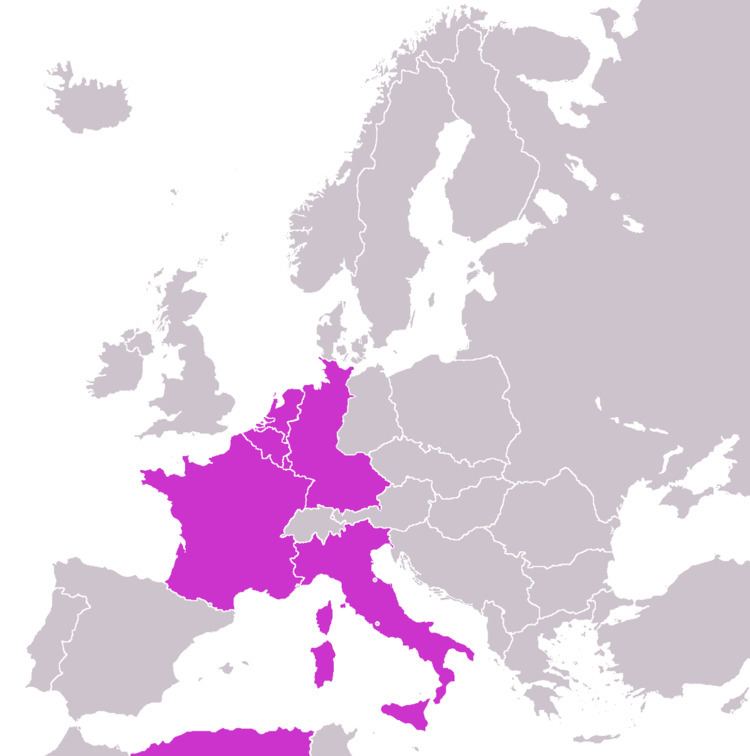 | ||
The European Defence Community (EDC) emerged from the Pleven plan proposed in 1950 by René Pleven, the French Prime Minister, in response to the American call for the rearmament of West Germany. The intention was to form a pan-European defence force as an alternative to Germany's proposed accession to NATO, meant to harness its military potential in case of conflict with the Soviet bloc. The EDC was to include West Germany, France, Italy, and the Benelux countries. Just as the Schuman Plan was designed to end the risk Germany having the economic power on its own to make war again, the Pleven Plan and EDC were meant to prevent the military possibility of Germany's making war again. A treaty was signed on 27 May 1952, but the plan never went into effect. Instead Germany was admitted into NATO.
Contents
Historical background
During the late 40s, the divisions created by the Cold War were becoming more and more evident. The United States looked with suspicion at the growing power of the USSR and European states felt vulnerable, fearing a possible Soviet occupation. In this climate of mistrust and suspicion, the United States considered the rearmament of West Germany as a possible solution to enhance the security of Europe and of the whole Western bloc. In September 1950, Dean Acheson proposed a new plan to the European states; the American plan, called package, sought to enhance NATO's defense structure, creating 12 West German divisions. However, after the destruction that Germany had caused during World War II, European countries, and in particular France, were not ready to see the reconstruction of the German military. Finding themselves in the midst of the two superpowers, they looked at this situation as a possibility to enhance the integration process, trying to obviate the loss of military influence caused by the new bipolar order. On 24 October 1950, France's Prime Minister René Pleven proposed a new plan, which took his name, that aimed to create a supranational European Army. With this project, France tried to satisfy America's demands, avoiding, at the same time, the creation of German divisions, and thus the rearmament of Germany.
Organisation
Although with some doubts and hesitation, the United States and the six members of the European Community approved the Pleven Plan. This led the way to the Paris Conference, launched in February 1951, where it was negotiated the structure of the supranational army. Among compromises and diffidences, on 27 May 1952 the six foreign ministers signed the Treaty of Paris establishing the European Defence Community (EDC). The EDC would have established a pan-European military, divided into national components. In this military, the French, Italian, Belgian, Dutch and Luxembourgish components would report to their national governments, whereas the West German component would report to the EDC. This was due to the fear of a return of German militarism, so it was desired that the German government would not have control over the German military. However, in the event of its rejection, it was agreed to let the West German government control its own military in any case (something which the treaty would not have provided). The EDC also provided for centralized military procurement. The EDC would have had a common budget, arms and institutions.
Failure
The plan collapsed when it failed to obtain ratification in the French Parliament. The reasons that led to the failed ratification of the Treaty were twofold, concerning major changes in the international scene, as well as domestic problems of the French Fourth Republic. There were Gaullist fears that the EDC threatened France's national sovereignty, constitutional concerns about the indivisibility of the French Republic, and fears about West Germany's remilitarization. French Communists opposed a plan tying France to the capitalist United States and setting it in opposition to the Communist bloc. Other legislators worried about the absence of the United Kingdom. The EDC went for ratification in the French National Assembly on 30 August 1954, and failed by a vote of 319 against 264. By this time, concerns about a future conflict faded with the death of Joseph Stalin and the end of the Korean War. Concomitant to these fears were a severe disjuncture between the original Pleven Plan of 1950 and the one defeated in 1954. Divergences included military integration at the division rather than battalion level and a change in the command structure putting the NATO Supreme Commander in charge of EDC operational capabilities. Then Prime Minister, Pierre Mendès-France, tried to placate the treaty's detractors by attempting to ratify additional protocols with the other signatory states. These included the sole integration of covering forces, or in other words, those deployed within West Germany, as well as the implementation of greater national autonomy in regard to budgetary and other administrative questions. Britain approved of the plan in principle, but agreed to join only if the supranational element was decreased.
European organisations with similar tasks
After the failed ratification in the French National Assembly, the EC member states tried to create foreign policy cooperation in the De Gaulle-sponsored Fouchet Plan (1959–1962). European foreign policy was finally established during the third attempt with European Political Cooperation (EPC) (1970). This became the predecessor of the Common Foreign and Security Policy (CFSP).
Today the European Union and NATO, and formerly also the Western European Union, all carry out some of the functions which was envisaged for the EDC, although none approach the degree of supranational military control that the EDC would have provided for.
